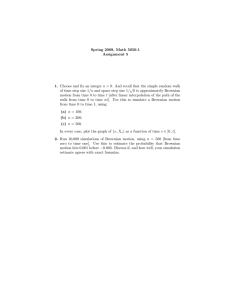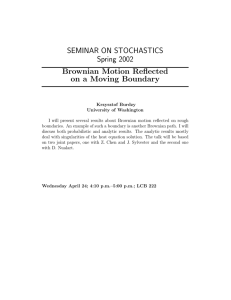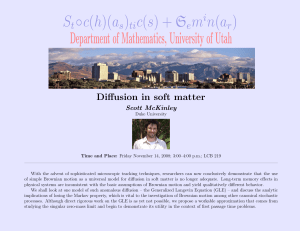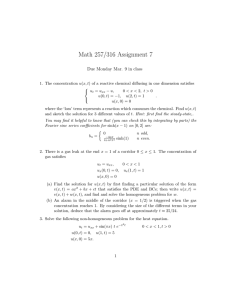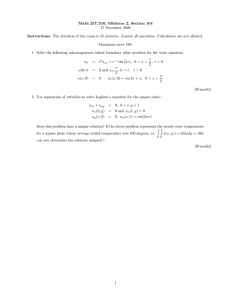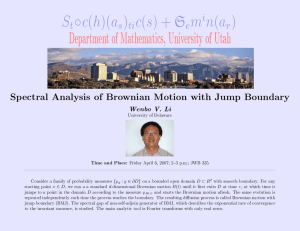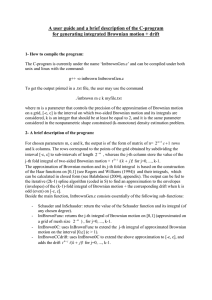7. Brownian Motion as a Markov process.
advertisement
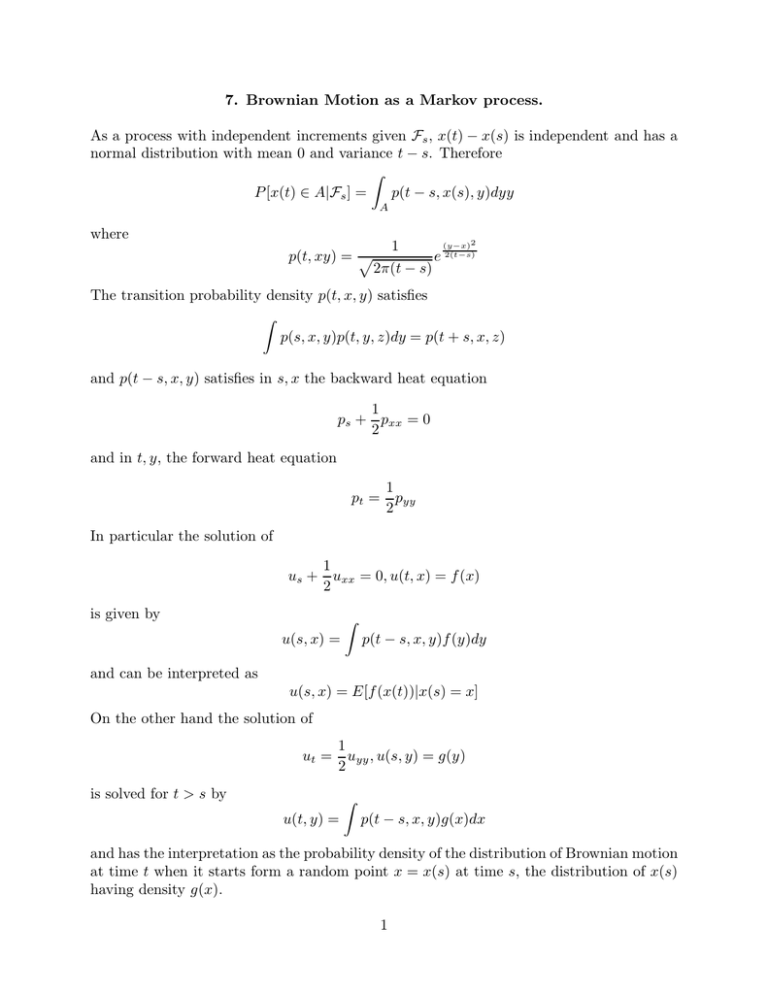
7. Brownian Motion as a Markov process.
As a process with independent increments given Fs , x(t) − x(s) is independent and has a
normal distribution with mean 0 and variance t − s. Therefore
Z
P [x(t) ∈ A|Fs ] =
p(t − s, x(s), y)dyy
A
where
p(t, xy) = p
(y−x)2
1
e 2(t−s)
2π(t − s)
The transition probability density p(t, x, y) satisfies
Z
p(s, x, y)p(t, y, z)dy = p(t + s, x, z)
and p(t − s, x, y) satisfies in s, x the backward heat equation
1
ps + pxx = 0
2
and in t, y, the forward heat equation
pt =
1
pyy
2
In particular the solution of
1
us + uxx = 0, u(t, x) = f (x)
2
is given by
u(s, x) =
Z
p(t − s, x, y)f (y)dy
and can be interpreted as
u(s, x) = E[f (x(t))|x(s) = x]
On the other hand the solution of
ut =
1
uyy , u(s, y) = g(y)
2
is solved for t > s by
u(t, y) =
Z
p(t − s, x, y)g(x)dx
and has the interpretation as the probability density of the distribution of Brownian motion
at time t when it starts form a random point x = x(s) at time s, the distribution of x(s)
having density g(x).
1
One can check these things by differentiating
under the integral sign and the boundary
R
condition is verifies by checking that p(t, x, y)dy = 1 and
Z
p(t, x, y)dy = 0
lim
t→0
|x−y|≥ǫ
There is an important connection between Brownian motion and the operator δt + 21 δx2
besides the ones described above.
Fact. Let u(t, x) be a nice function. Smooth and well behaved at ∞. Let f (t, x) =
Rt
ut + 21 uxx . Then u(t, x(t)) − s f (σ, x(σ))dσ is a maringale with respect to Brownian
motion starting from any point x at time s.
Proof. We need to prove
E[u(t, x(t)) − u(s, (x(s)) −
Z
t
f (σ, x(σ))dσ|Fσ] = 0
s
This is just verifying
Z
u(t, y)p(t − s, x, y)dy − u(s, x) −
Z tZ
f (σ, y)p(σ − s, x, y)dydσ = 0
s
It is enough to check for functions of the form u(t, x) = g(t)eiξ x . Then
f (t, x) = [g ′ (t) −
Note that
Z
ξ2
g(t)]ei ξ x
2
ei ξ y p(t, x, y) = ei ξ x e−
ξ2 t
2
We need to check
iξx −
e
e
ξ2 (t−s)
2
iξx
g(t) − e
g(s) =
Z
t
ei ξ x [g ′ (σ) − g(σ)
s
or
−
e
ξ2 (t−s)
2
g(t) − g(s) =
Z
s
t
ξ 2 − ξ2 (σ−s)
2
]e
dσ
2
ξ 2 − ξ2 (σ−s)
2
[g (σ) − g(σ) ]e
dσ
2
′
which is easily carried out. A consequence is the maximum principle. For any solution u
of ut + 12 uxx = 0, u(t, x(t)) is a martingale. In particular
u(s, x) = E[u(t, x(t))|Fs] =
Z
u(t, y)p(t − s, x, y)dy
If u(t, y) ≥ 0, then so is u(s, y) for s ≤ t. In particular this proves the uniqueness of
solutions.
2
One can have functions defined in a region. For instance s ≤ t ≤ T, |x| ≤ 1. Then
τ = min{T, inf{t : |x(t)| ≥ 1}} is a stopping time and
E[u(τ, x(τ )) − u(s, x(s)) −
Z
τ
f (σ, x(σ))dσ|x(s) = x] = 0
s
There are multi dimensional versions of Brownian motion. Just take independent versions
{xj (t); 1 ≤ j ≤ d} to get the d-diemsional version.
p(t, {xj }, {yj }) = Πdj=1 p(t, xj , yj )
The backward differential equation is
d
∂
1
∂
1 X ∂2
+ ∆=
+
∂t 2
∂t 2 j=1 ∂x2j
3

